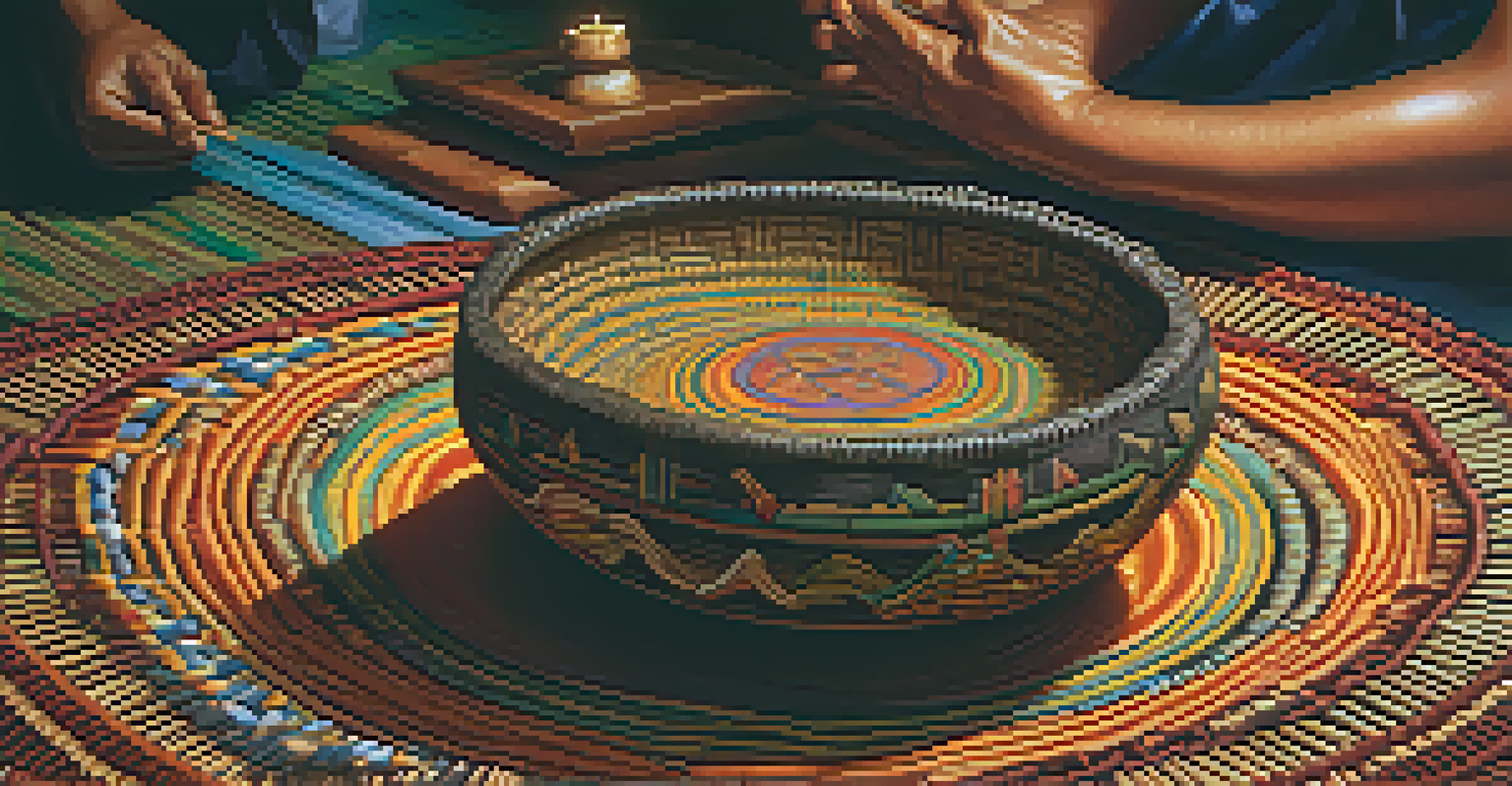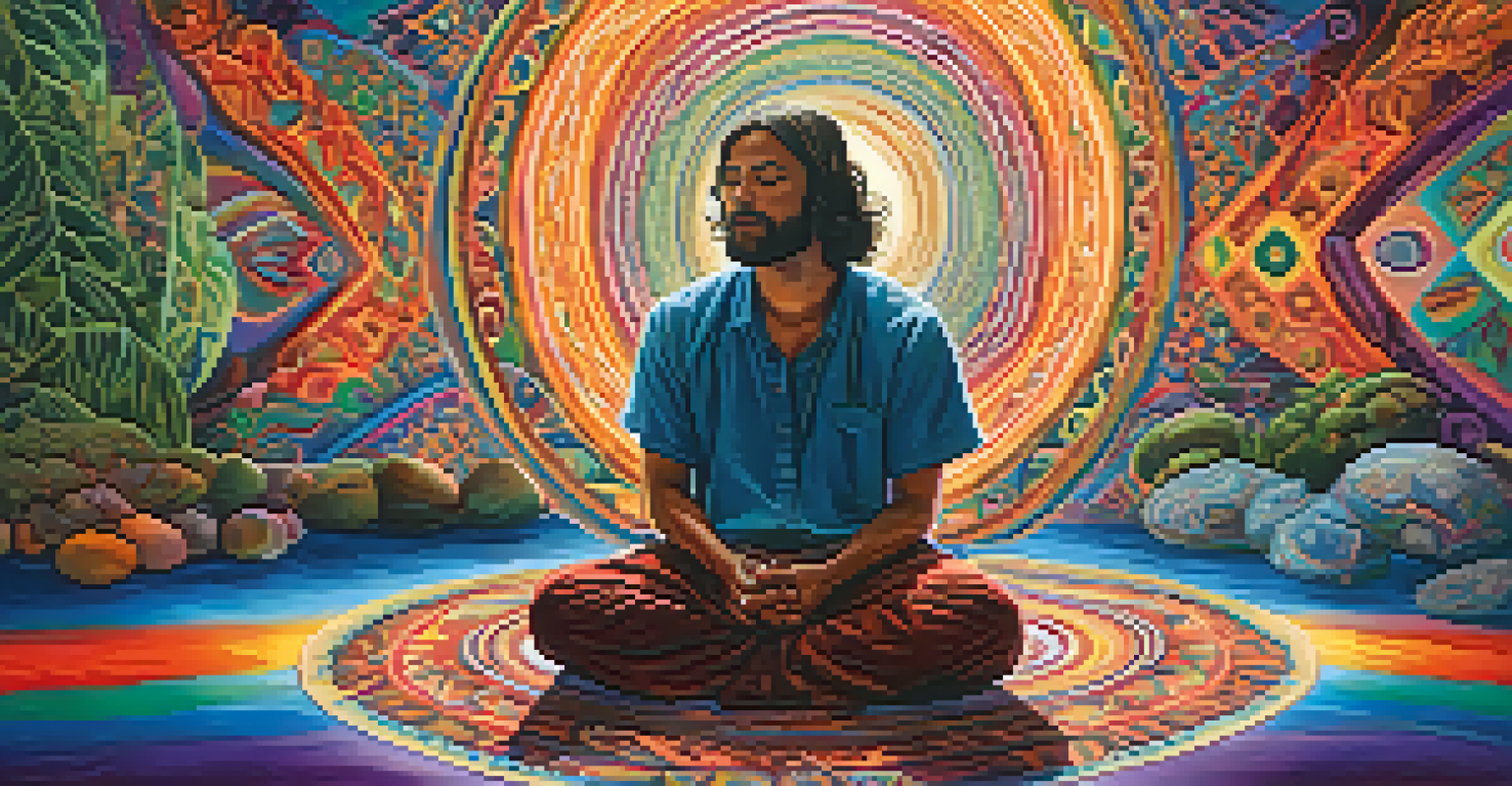Ayahuasca Ceremonies: A Pathway to Holistic Well-being

What is Ayahuasca and Its Cultural Significance?
Ayahuasca is a traditional South American brew made from the Banisteriopsis caapi vine and other plants. It has been used for centuries by indigenous tribes in the Amazon for spiritual and healing purposes. The brew is known for its psychoactive properties, primarily due to the presence of DMT, which can facilitate profound psychological experiences.
The experience of Ayahuasca can be a powerful catalyst for personal transformation and healing.
In these cultures, Ayahuasca is not just a drink but a sacred tool used to connect with the spirit world. Shamans, or healers, guide participants through the experience, which can lead to insights about personal struggles and life’s purpose. This deep-rooted cultural significance is what sets Ayahuasca apart from other therapeutic methods.
Understanding Ayahuasca’s cultural context enriches the experience for participants. It helps them appreciate the ceremonial aspects and the respect given to the plants and the shamanic traditions, allowing for a more profound and meaningful journey.
The Journey of an Ayahuasca Ceremony
An Ayahuasca ceremony typically begins with participants gathering in a safe, supportive environment led by an experienced shaman. The atmosphere is often imbued with ritualistic elements, including music, chanting, and the use of sacred objects. This preparation sets the tone for the transformative experience ahead.

Once the participants drink the Ayahuasca brew, they may begin to feel its effects within an hour. Experiences can vary widely, from vivid visual hallucinations to emotional catharsis and deep introspection. During this time, participants are encouraged to surrender to the experience and let go of control, which is essential for healing.
Ayahuasca's Cultural Importance
Ayahuasca is a sacred brew used by indigenous tribes for spiritual healing and connection with the spirit world.
The journey can last several hours, during which participants may confront personal traumas, fears, or unresolved issues. The shaman's guidance throughout this process is crucial, as they help navigate the emotional landscape and ensure a safe environment for healing and growth.
Potential Benefits of Ayahuasca Ceremonies
Many participants report a wide array of benefits following Ayahuasca ceremonies, including emotional healing, clarity of thought, and a profound sense of connection to themselves and others. The experience can lead to breakthroughs in understanding personal challenges and fostering resilience.
Ayahuasca is not just a drink, but a means to access deeper layers of consciousness and heal the soul.
Research suggests that Ayahuasca may help alleviate symptoms of mental health disorders like depression, anxiety, and PTSD. These potential benefits stem from the introspective nature of the experience and the neurobiological effects of DMT on the brain, promoting new pathways for healing.
Beyond mental health, participants often describe a newfound appreciation for life and nature after their experiences. The sense of unity and interconnectedness can inspire individuals to adopt healthier lifestyles and foster a more compassionate approach to themselves and the world around them.
Preparing for Your Ayahuasca Experience
Preparation for an Ayahuasca ceremony is crucial for maximizing its healing potential. It typically involves physical, emotional, and spiritual readiness. Participants are often advised to follow a specific diet leading up to the ceremony, avoiding certain foods and substances to ensure a safe experience.
Mentally and emotionally preparing is equally important. This could involve journaling, meditation, or discussing intentions with the shaman or group. Clear intentions can guide the experience and help participants remain focused on their personal growth during the ceremony.
Benefits of Ayahuasca Experiences
Participants often report emotional healing and new perspectives on life following Ayahuasca ceremonies.
Lastly, it’s vital to choose a reputable retreat or facilitator. Researching their background, understanding the ceremonial practices, and ensuring a safe environment can significantly influence the overall experience, making preparation an integral part of the journey.
Post-Ceremony Integration: Making Sense of the Experience
The journey doesn’t end once the effects of Ayahuasca wear off. Post-ceremony integration is a critical phase, where individuals reflect on their experiences and apply insights to their daily lives. This process helps in translating the often profound realizations into actionable changes.
Many participants find it helpful to engage in discussions with the shaman or fellow participants after the ceremony. Sharing experiences can foster a sense of community and provide additional perspectives that enrich understanding. Some choose to continue their healing journey through therapy or support groups.
Journaling is another effective tool for integration. Writing down thoughts and feelings about the experience can clarify insights and embed them into one's life, ensuring that the lessons learned during the ceremony contribute to long-term well-being.
The Role of Shaman in Ayahuasca Ceremonies
The shaman plays a vital role in an Ayahuasca ceremony, acting as a guide and protector. Their expertise in the ceremonial process and deep understanding of the brew’s effects are crucial for ensuring a safe and transformative experience. Shamans often undergo years of training and personal experiences to prepare for this responsibility.
During the ceremony, the shaman utilizes traditional songs, known as icaros, to guide participants through their journeys. These songs are believed to have healing properties and can evoke specific emotional responses, helping individuals navigate the often challenging landscapes of their psyche.
Preparation and Safety Essentials
Proper preparation and choosing reputable facilitators are crucial for maximizing the healing potential of Ayahuasca.
Additionally, the shaman's presence fosters a sense of safety and support. Participants can trust their guidance as they confront personal fears or traumas, making the shaman's role indispensable in facilitating a successful and healing ceremony.
Safety Considerations and Risks of Ayahuasca
While Ayahuasca can offer profound healing, it’s essential to consider the potential risks involved. Individuals with certain medical conditions, especially mental health disorders, should consult healthcare professionals before participating. The brew can interact negatively with certain medications, leading to dangerous side effects.
Moreover, the intensity of the experience can be overwhelming for some. It’s important to approach Ayahuasca with a mindset of readiness and respect, understanding that the journey can bring up difficult emotions or memories that need to be processed.

Choosing a safe and supportive environment is paramount. Ensuring the retreat or ceremony is led by experienced and reputable facilitators can significantly mitigate risks and enhance the overall experience, paving the way for healing and transformation.